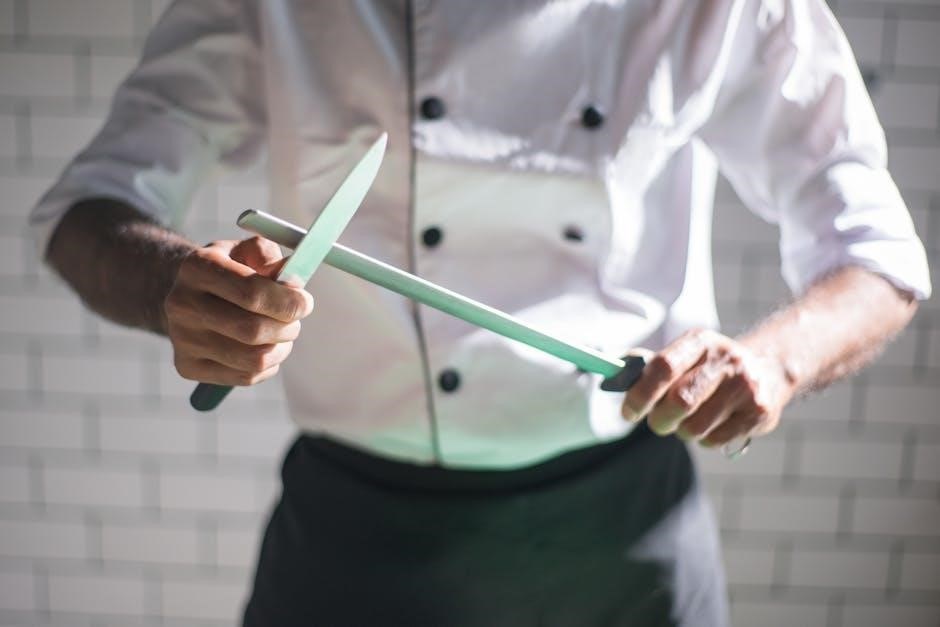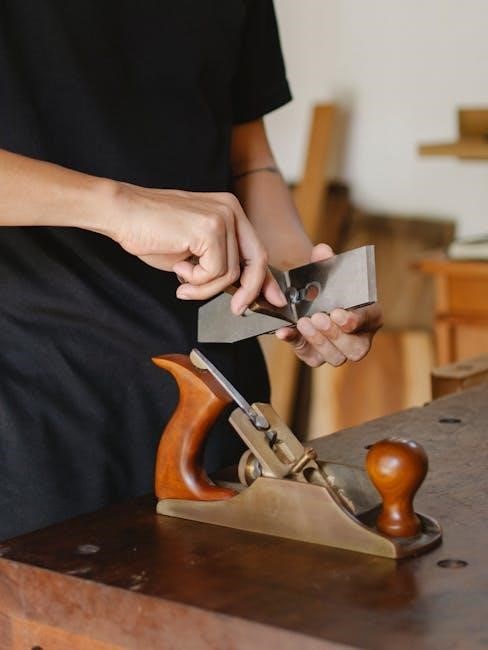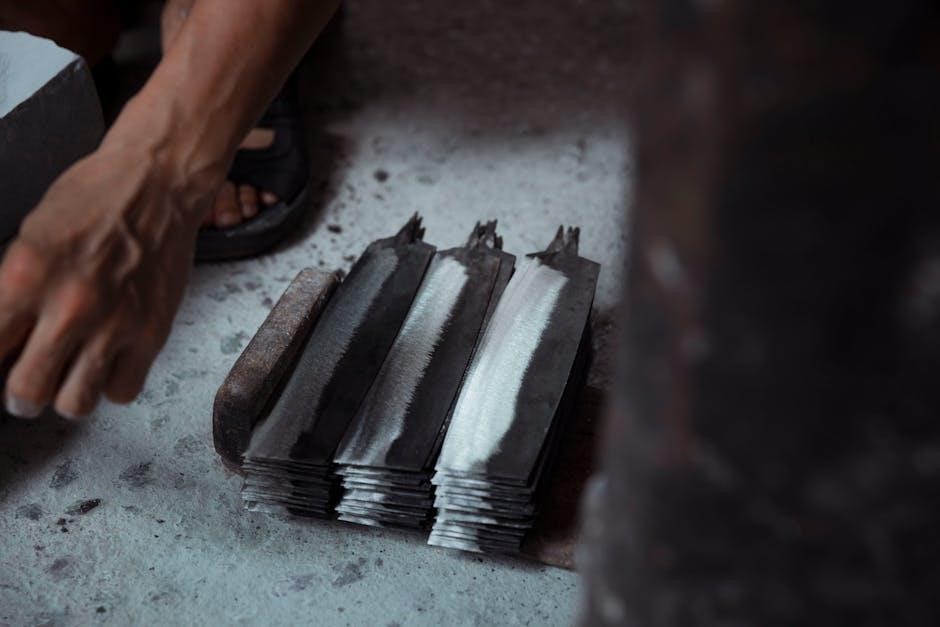Knife sharpening angle guides are essential tools for achieving precise blade edges. They help maintain consistent angles, crucial for sharpness and durability. These devices have evolved from simple mechanical aids to advanced laser-guided systems, catering to both beginners and experts. By ensuring the correct angle, they prevent over-sharpening and extend knife life, making them indispensable for enthusiasts and professionals alike.
1.1 Why Angle Guides Are Essential for Sharpening
Angle guides are crucial for maintaining precise control during sharpening, ensuring the blade reaches its optimal sharpness. They prevent over-sharpening, which can weaken the knife, and help achieve consistent results. Guides are especially vital for beginners, as they simplify angle determination. For experts, they provide reliability and efficiency. The correct angle varies by knife type, with softer steels requiring steeper angles and harder steels needing lower ones. Using a guide ensures the edge aligns perfectly, enhancing durability and performance, making them an indispensable tool for all sharpening tasks.
1.2 Brief History of Angle Guides in Knife Sharpening
Angle guides have evolved significantly, transitioning from simple mechanical aids to advanced tools like laser-guided systems. Originally, sharpeners relied on manual techniques, using their thumbs and index fingers to estimate angles. By the 1990s, experienced sharpeners could identify specific degrees, such as 17° or 20°, through practice. However, this method was challenging for beginners, leading to the development of mechanical angle guides. These tools simplified the process, ensuring consistency. The introduction of laser-guided systems in recent years further enhanced precision, making sharpening accessible to everyone; This evolution reflects the growing demand for efficient, accurate sharpening solutions.

Types of Knife Sharpening Angle Guides
Knife sharpening angle guides come in various forms, including roller-style, clamp-on, and laser-guided tools, each designed to help achieve precise sharpening angles for different knife types.
2.1 Roller-Style Angle Guides
Roller-style angle guides are simple, mechanical tools designed to help maintain consistent sharpening angles. They typically feature adjustable rollers that glide along the knife’s edge, ensuring precise control. These guides are versatile and work well with various sharpening surfaces, including whetstones and steel rods. By aligning the knife at the desired angle, they prevent uneven sharpening and extend the blade’s life. Roller-style guides are particularly popular among beginners, as they simplify the learning process of achieving the perfect edge. Their portability and ease of use make them a favorite for both hobbyists and professionals.
2.2 Clamp-On Angle Guides
Clamp-on angle guides are sturdy tools that attach securely to the sharpening surface, ensuring precise angle control. They are highly adjustable, allowing users to set specific angles for different knife types. These guides are ideal for maintaining consistency and preventing errors, especially for those new to sharpening. By clamping onto the whetstone or steel, they provide stability and ease of use. Clamp-on guides are versatile and work well with various sharpening tools, making them a reliable choice for achieving sharp, professional-grade edges with minimal effort.
2.3 Laser-Guided Angle Tools
Laser-guided angle tools represent the pinnacle of precision in knife sharpening. These advanced devices use laser technology to project a clear, visible line indicating the ideal sharpening angle. They are highly accurate and eliminate guesswork, ensuring consistent results. Laser guides are particularly useful for beginners, as they provide real-time feedback and help develop muscle memory. Their adjustability and ease of use make them suitable for various knife types. Despite their higher cost, laser-guided tools offer unmatched precision, making them a valuable investment for serious sharpening enthusiasts and professionals seeking flawless edges.
How to Determine the Correct Sharpening Angle
Determining the correct sharpening angle involves understanding the knife type and its intended use. Markers or thumb placement can help test and maintain the ideal angle, ensuring precision and consistency for optimal sharpness.
3.1 Understanding Knife Types and Their Ideal Angles
Knife types vary, and each requires specific angles for optimal sharpness. Kitchen knives typically use 17-20 degrees, while pocket and outdoor knives range from 20-25 degrees. Japanese knives often require sharper angles, such as 15-18 degrees, for precision cutting. Softer steels benefit from steeper angles, while harder steels perform better at lower angles. Understanding the knife’s intended use and steel type helps determine the ideal angle, ensuring effectiveness and longevity of the blade. This knowledge is foundational for mastering the sharpening process.
3.2 Using a Marker to Test the Angle
Using a marker to test the angle is a practical method to ensure accuracy during sharpening. Mark the knife’s edge with a permanent marker, focusing on a small section. As you sharpen, observe how the marker wears off. If the marker remains, adjust the angle; if it fades unevenly, your angle may be off. This technique provides immediate feedback, helping you find the ideal angle without special tools. It’s especially useful for developing muscle memory and ensuring consistent results across different knife types.
3.3 The Role of Thumb and Index Finger in Feeling the Angle
Experienced sharpeners often use their thumb and index finger to gauge the sharpening angle. The angle is typically measured between the thumb and the knife’s edge, with the index finger guiding the blade’s position. This method relies on developing muscle memory to consistently replicate the desired angle. For example, a 17-20 degree angle can be approximated by aligning the knife’s edge with the first joint of the thumb. This tactile approach is invaluable for maintaining precision and is especially useful when no angle guide is available, making it a skill worth mastering for both beginners and experts alike.

Common Sharpening Angles for Different Knives
Most knives are sharpened at 17-20 degrees for kitchen use, while pocket and outdoor knives often range from 20-25 degrees. Japanese knives typically use sharper angles of 15-18 degrees.
4.1 Kitchen Knives: 17-20 Degrees
Kitchen knives typically require a sharpening angle of 17-20 degrees for optimal performance. This range balances sharpness and durability, making it ideal for everyday use. A 20-degree angle is most common, as it provides a strong edge for cutting through various foods. For lighter tasks, such as slicing vegetables, a slightly sharper 17-degree angle may be preferred. Using an angle guide ensures consistency, preventing over-sharpening and extending the knife’s life. This range is versatile enough for both straight-edge and serrated kitchen knives.
4.2 Pocket and Outdoor Knives: 20-25 Degrees
Pocket and outdoor knives are best sharpened at a 20-25 degree angle, balancing sharpness and edge strength. This range suits their tough, versatile use, from cutting ropes to hard materials. The slightly more obtuse angle enhances durability, reducing the risk of chipping during rugged tasks. Angle guides are crucial for consistency, preventing over-sharpening and ensuring efficient maintenance. This angle is ideal for various steel types and maintains the knife’s geometry, crucial for outdoor reliability and performance.
4.3 Japanese Knives: Sharper Angles (15-18 Degrees)
Japanese knives are sharpened at 15-18 degrees, requiring precise angle guides for their sharp, delicate edges. This narrower angle enhances cutting precision, ideal for slicing and filleting. The acute angle demands careful technique, often assisted by specialized guides to maintain consistency. These knives, typically made from hard steel, benefit from lower angles for superior edge retention. Using angle guides ensures the maintenance of their unique geometry, preserving their renowned sharpness and performance in culinary tasks.

How to Use an Angle Guide Effectively
Align the knife at the desired angle using the guide. Maintain consistent pressure and stroke direction to ensure precision and avoid over-sharpening, enhancing the blade’s longevity.
5.1 Step-by-Step Guide to Sharpening with an Angle Guide
To sharpen effectively, position the knife at the desired angle using the guide. Hold the knife firmly and draw it across the sharpening surface in smooth, consistent strokes. Check the edge regularly with a marker to ensure even sharpening. Flip the knife to sharpen the other side, maintaining the same angle. Light pressure and steady movement are key to avoiding over-sharpening. Repeat until the edge is sharp, then finish with a clean, light stroke to remove any micro-burs. This method ensures precision and longevity for your blade.
5.2 Tips for Maintaining Consistency
Maintaining consistency when sharpening requires attention to detail and repetition. Always use the same sharpening stone or surface to ensure uniformity. Keep the angle guide securely attached to prevent slippage during strokes. Apply steady, light pressure and move the knife in smooth, controlled motions. Regularly inspect the edge with a marker to track progress. By following these practices, you can achieve a consistently sharp edge, enhancing both the knife’s performance and its longevity. Consistency is key to mastering the sharpening process effectively.
Choosing the Right Angle Guide for Your Needs
Selecting the right angle guide involves considering material durability, adjustability, and ease of use. Choose tools that suit your skill level and sharpening frequency for optimal results.
6.1 Factors to Consider: Material, Adjustability, and Ease of Use
When selecting an angle guide, consider its material, as steel and plastic options vary in durability and portability. Adjustability is crucial for versatility, allowing use with different knife types and angles. Ease of use is key, especially for beginners, ensuring a smooth learning curve. Lightweight designs enhance maneuverability, while robust constructions offer long-term reliability. Prioritize features that align with your sharpening frequency and skill level to optimize performance and satisfaction. Balancing these factors ensures the right tool for your needs.
6.2 Recommendations for Beginners vs. Experienced Sharpeners
Beginners benefit from angle guides with simplicity and clear markings, helping them maintain consistent angles without confusion. Experienced sharpeners may prefer adjustable or precision tools, allowing for refined control. For those new to sharpening, opt for guides with visual indicators or preset angles to build confidence. Seasoned users can explore advanced features like micro-adjustments or customizable settings for specialized tasks. Matching the tool to skill level ensures effective sharpening and enhances the learning process for beginners while catering to the precision needs of experts. This balance maximizes efficiency and satisfaction.

Maintenance and Care of Angle Guides
Regular cleaning with mild detergents, thorough drying to prevent rust, and storing in protective cases ensure longevity. Avoid extreme temperatures and abrasive materials.
7.1 Cleaning and Storing Your Angle Guide
Cleaning your angle guide regularly is vital to maintain its accuracy and longevity. Use a soft cloth dampened with mild soap and water to wipe down the surface, ensuring no abrasive materials scratch the guide. After cleaning, thoroughly dry the tool to prevent rust or corrosion. Store the angle guide in a protective case or pouch to shield it from dust and accidental damage. Proper storage ensures it remains in optimal condition for future use.
7.2 Troubleshooting Common Issues
Common issues with angle guides include misalignment, wear, and difficulty adjusting angles. Check for loose parts and tighten screws if necessary. If the guide slips during use, ensure the knife is held firmly and the surface is stable. For stubborn angles, refer to the manufacturer’s instructions or calibration guidelines. Regular maintenance, such as cleaning and proper storage, can prevent many of these problems. Addressing issues promptly ensures consistent and effective sharpening results.
Knife sharpening angle guides are indispensable for achieving precision and consistency. They enhance sharpness, prevent over-sharpening, and extend blade life, making them essential for both enthusiasts and professionals.
8.1 Key Takeaways for Effective Knife Sharpening
Consistent angles are crucial for sharpness and durability. Guides ensure precision, preventing over-sharpening and extending blade life. Beginners benefit from adjustable tools, while experts rely on thumb placement. Testing angles with markers or fingers enhances accuracy. Softer steels require steeper angles, while harder steels prefer lower ones. Regular maintenance and proper storage of guides are essential. By mastering these techniques, anyone can achieve professional-level sharpness, making angle guides indispensable for all knife enthusiasts.
8.2 The Future of Angle Guides in Sharpening Technology
The future of angle guides promises advanced precision and innovation. Emerging technologies like AI-powered sharpening tools and smart sensors could offer real-time angle feedback. Laser-guided systems may become more affordable and widespread. Eco-friendly materials and adjustable designs tailored to specific knife types are expected to rise. These advancements aim to simplify the sharpening process for beginners while enhancing efficiency for experts. As technology evolves, angle guides will continue to play a pivotal role in achieving razor-sharp edges with minimal effort.
